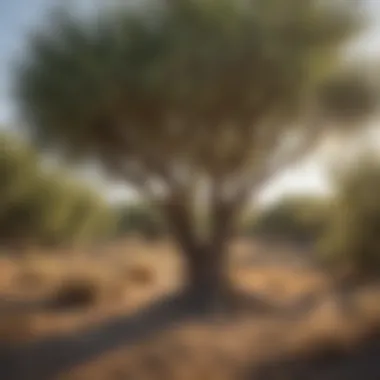Exploring the Ecological Importance of Desert Willow Trees


Intro
The Desert Willow tree, scientifically known as Chilopsis linearis, finds its home in the arid landscapes of Texas. This tree is not only visually appealing with its delicate flowers and slender leaves but also serves as a crucial component of the local ecosystem. The focus of this article is to explore various facets of the Desert Willow, including its ecological significance, growth requirements, and cultural relevance across Texas.
Understanding the role of the Desert Willow in woodland maintenance and biodiversity is essential. This knowledge is invaluable for enthusiasts, gardeners, and forestry professionals aiming to promote sustainable practices in their landscapes. By providing a comprehensive view, we will illuminate how this tree species contributes to its environment and how it can be integrated into responsible gardening methods.
Forest Ecology and Biodiversity
Importance of Forest Ecosystems
Forest ecosystems play a critical role in maintaining ecological balance. They contribute to carbon sequestration, help regulate water cycles, and offer habitat for diverse species. The Desert Willow, although often found in riparian regions, can adapt to varying conditions, making it a vital tree in drought-prone areas. Its capacity to thrive in poor soil reflects its evolutionary adaptations, providing sustenance and habitat for other organisms.
Flora and Fauna in Woodlands
The biodiversity present in woodlands, including areas where the Desert Willow flourishes, is intricate. This tree serves as a food source and shelter for various birds, insects, and small mammals. Its flowers attract pollinators such as bees and butterflies, establishing a delicate balance within the ecosystem. Additionally, its foliage provides cover for nesting birds and other wildlife, making it essential for habitat preservation.
"The adaptability of the Desert Willow enhances its ecological value, creating microhabitats that foster varied species interactions."
Understanding these dynamics enhances our approach to conservation. Recognizing how the Desert Willow interacts with its environment can guide forestry practices that honor local ecosystems while promoting healthy landscapes.
Sustainable Forestry Practices
Techniques for Responsible Management
Sustainable forestry practices aim to balance ecological health with economic needs. For the Desert Willow, responsible management can ensure its role in biodiversity continues while also offering aesthetic value. Techniques include:
- Proper Pruning: Helps maintain the tree’s health and promotes vigorous growth.
- Mulching: Reduces competition from invasive species while retaining soil moisture.
- Irrigation Management: Ensures optimal water consumption without overdependencies on artificial sources.
Implementing these practices not only benefits the tree but also the surrounding ecosystem, fostering a sustainable environment.
Certification Schemes and Standards
Engaging with recognized standards helps promote responsible forestry. Organizations like the Forest Stewardship Council (FSC) provide frameworks for sustainable management. These guidelines support cultivating trees like the Desert Willow in a way that respects both the land and ecological integrity. By adhering to sustainable practices, landowners can contribute to the ongoing health of Texas’s unique environments.
Community Engagement and Stewardship
Role of Local Communities
Local communities play a significant role in the stewardship of the Desert Willow. Engagement in planting and maintaining these trees can foster a sense of responsibility for the local ecosystem. Environmental awareness campaigns can inform citizens about the tree's role and benefits, encouraging planting initiatives in schools and parks. Communities that actively promote native species enhance the biodiversity of their surroundings.
Volunteer Opportunities for Engagement
Volunteering for local conservation organizations can provide hands-on experience with the Desert Willow and similar species. Opportunities can include:
- Tree Planting Events: Help re-establish native habitats.
- Education Programs: Teach others about the ecological importance of native trees.
- Restoration Projects: Restore areas affected by drought or invasive species.
These engagements not only educate but also strengthen the bond between community members and their natural surroundings, fostering an appreciation for Texas’s unique environment.
Preface to the Desert Willow Tree
The Desert Willow tree holds a unique place in the ecosystem of Texas. It provides essential benefits both environmentally and culturally. With its resilience to arid climates, it plays a crucial role in supporting local wildlife while also offering aesthetic appeal to landscapes. The examination of this tree entails understanding its biological classification, distinctive features, and distribution across Texas.


Botanical Classification
The Desert Willow, scientifically known as Chilopsis linearis, is a member of the Bignoniaceae family. This classification places it among flowering plants known for their striking blooms and ornamental value. Native to the southern United States and Mexico, it thrives in dry conditions. Botanically, it is important to recognize that this tree is not a true willow despite its name. The Chilopsis linearis stands out in the Bignoniaceae family due to its peculiar adaptations to arid environments.
Physical Characteristics
In terms of physical traits, the Desert Willow can grow up to 25 feet tall. Its branches are long and slender, often bending gracefully. The leaves are narrow and linearly arranged, giving them a willow-like appearance. The tree showcases stunning trumpet-shaped flowers during blooming seasons, which can be white, pink, or lavender. This flowering generally occurs in summer and provides vital nectar for pollinators, including bees and hummingbirds. The bark is smooth and can take on a grayish-brown color, which provides some drought resistance.
Geographical Distribution in Texas
The geographic distribution of the Desert Willow in Texas is primarily in the central and southwestern regions. It is commonly found along riverbanks, in canyons, and in other areas with well-drained soils. This prevalence is due to its ability to adapt to poor soil conditions and periods of drought, making it a valuable species in these environments. Areas such as the Rio Grande Valley and various parks and reserves showcase its presence.
In summary, the Desert Willow tree is a vital component of Texas' flora. Understanding its classification, characteristics, and distribution enhances the appreciation of its role in the ecology and landscape design.
Ecological Significance
The ecological importance of the Desert Willow tree cannot be overstated. It provides a range of benefits crucial to its environment. In Texas, the adaptability of the Desert Willow to various soil types and climatic conditions makes it a cornerstone species within its habitat. This tree works in concert with the local ecosystem, contributing to biodiversity, soil health, and water conservation. Additionally, it plays a vital role in the stability of the habitats it occupies, acting as a refuge for numerous species.
Habitat and Soil Preferences
Desert Willows thrive in a range of soil types but prefer well-drained soils. They can tolerate sandy, loamy, and even clay soils, provided the drainage is adequate. This adaptability makes them suitable for a variety of landscapes in Texas, from riverbanks to arid plains. They often grow in areas that are disturbed or degraded, showing resilience in challenging conditions. The ideal soil pH for Desert Willows is between 6.0 and 8.0.
Maintaining soil health is crucial for the Desert Willow's growth and health. Mulching can help retain moisture and reduce competition from weeds. The presence of organic matter in the soil supports microbial life, promoting nutrient availability for the tree.
Water Requirements and Drought Resistance
The Desert Willow exhibits excellent drought resistance. This is particularly important in the Texas climate, where water scarcity can often be a concern. The tree has adapted to survive on minimal water once established. In its natural habitat, it receives occasional rainfall, which is enough to support its growth.
During the initial planting phase, regular watering is important. After establishment, watering needs decrease significantly. Micro-drip irrigation systems are ideal for saving water while ensuring the tree's survival during dry spells. In times of prolonged drought, the Desert Willow will shed leaves to conserve water, demonstrating its remarkable adaptation.
Support for Local Wildlife
One of the most significant aspects of the Desert Willow is its role in supporting local wildlife. This tree provides essential habitat and food for various species. Many birds, such as hummingbirds and butterflies, are attracted to its fragrant, tubular flowers, which bloom in summer. These flowers serve as a critical nectar source, aiding in the pollination of other plants.
In addition, the tree's leaves and seed pods offer food for local herbivores. The sturdy branches also provide nesting sites for birds. The presence of Desert Willows in an area can increase local biodiversity, making them an important component of healthy ecosystems.
"The Desert Willow is more than just a pretty tree; it’s a lifeline for many species that rely on it for sustenance and shelter."
Cultivation Practices
The cultivation practices surrounding the Desert Willow tree, Chilopsis linearis, are essential for ensuring its successful growth and longevity. Understanding how to nurture this tree not only enhances its beauty in landscapes, but also reinforces its role in local ecosystems. This section outlines crucial factors such as optimal growing conditions, planting techniques, maintenance and care, as well as pruning and health management.
Optimal Growing Conditions
Desert Willows thrive in specific environmental circumstances that mimic their native habitats. They prefer well-draining soil, often found in sandy or gravelly formats. The tree exhibits a notable resilience to drought, making it suitable for arid and semi-arid regions. It is recommended to plant the tree in full sun, as it requires substantial light exposure for healthy growth.
Temperature: The Desert Willow can withstand extreme heat, tolerating temperatures up to 100°F (38°C) and even lower temperatures in winter down to about 20°F (-6°C).
Soil pH:
Slightly alkaline to neutral soil pH (between 6.0 and 7.5) enhances its growth potential. Providing these optimal conditions fosters robust development and vibrant flowering.
Planting Techniques


Proper planting techniques are vital for the establishment of a healthy Desert Willow tree. It is advisable to plant it during the spring or early summer, when the risk of frost has passed. Follow these steps to plant effectively:
- Site Selection: Choose a well-drained area that receives ample sunlight.
- Preparation: Dig a hole that is twice as wide as the root ball but no deeper than the ball itself.
- Planting: Place the tree in the hole, ensuring that the top of the root ball is level with the ground surface. Backfill the hole gently, covering roots with soil and removing air pockets.
- Watering: After planting, water thoroughly. Establishing a routine watering schedule for the first few weeks is crucial.
Maintenance and Care
Maintaining the health of the Desert Willow requires minimal effort, but attention to detail is beneficial. Regular monitoring for pests and diseases is essential for an effective care routine. Here are important maintenance practices:
- Watering: Established trees need little water, but during dry spells, periodic watering can be advantageous.
- Mulching: A layer of mulch around the base helps retain moisture and suppress weeds.
- Fertilization: Fertilizing once in spring can enhance growth, though many trees thrive without additional nutrients.
Pruning and Health Management
Pruning is critical for managing the shape and health of the Desert Willow. Follow these guidelines:
- Timing: The best time to prune is in late winter or early spring before new growth begins.
- Techniques: Remove dead or diseased branches to promote healthier growth. Lightly thin out the canopy to improve air circulation, which can deter disease.
- New Growth: Encourage new shoots by cutting back older branches. This practice not only maintains an attractive form but can also rejuvenate aging trees.
By understanding the cultivation practices necessary for the Desert Willow tree, gardeners and landowners can achieve successful growth and integration into various landscapes. These guidelines highlight the tree's adaptability and underline its significance in contributing to sustainable gardening in Texas.
Landscape Uses
The landscape applications of the Desert Willow tree (Chilopsis linearis) extend beyond mere aesthetics. This section explores specific elements, benefits, and considerations regarding the use of this adaptable tree in various landscape designs. With its unique characteristics, the Desert Willow serves not only as a functional element, but it also enriches the ecological context in which it resides.
Aesthetic Applications in Urban Settings
In urban environments, the Desert Willow presents a striking contrast to traditional landscaping choices. Its slender, graceful form offers a native alternative to non-adaptive species. The tree's pendulous branches and beautiful, fragrant flowers contribute to a serene, natural atmosphere, ideal for parks, gardens, and streetscapes. The blooms, which typically appear in shades of lavender and white, create a vibrant visual impact, particularly during the blooming season in late spring and early summer.
Not only does it serve aesthetic purposes, but the tree also requires minimal maintenance, making it practical for urban planners. This low water requirement aligns with water conservation efforts and promotes sustainability in city landscapes. Considerations include the spacing between trees, as they can grow quite tall and spread wide, making careful placement essential.
Erosion Control and Soil Stabilization
The role of the Desert Willow in erosion control and soil stabilization is significant, especially in areas prone to soil degradation. Its extensive root system anchors the soil, reducing the likelihood of soil erosion during heavy rainfall or wind events. This adaptability to various soil types enhances its utility in preventing landscape damage.
In addition, its ability to thrive in arid climates makes the Desert Willow an excellent choice for rehabilitating areas affected by drought. It can improve soil health by promoting biodiversity in the root zone. Planting Desert Willows along slopes or near bodies of water can help stabilize banks, thereby reducing sediment runoff.
Integration in Xeriscaping Designs
The Desert Willow is an exemplary species for xeriscaping, a water-efficient landscape design strategy. Its low water demands enable homeowners and municipalities to conserve precious water resources. Incorporating this tree into xeriscape plans can create a visually appealing yet sustainable landscape, tailored specifically for arid environments.
Key points to consider in integration include:
- Planting in clusters: Grouping multiple trees can create a naturalized appearance while enhancing shade.
- Companion planting: Desert Willows can be paired with other drought-tolerant plants to create diverse ecosystems that attract beneficial wildlife.
- Location selection: Ensure that these trees are planted in areas with ample sunlight, as they thrive in full sun.
Integrating the Desert Willow into xeriscaping not only enhances aesthetic value but also aligns with broader environmental goals.
In summary, the Desert Willow tree offers a versatile option in landscaping practices. Its aesthetic appeal, erosion control capabilities, and fit within xeriscaping designs illustrate its role as both a decorative and functional tree in the environment.
Cultural and Historical Context
Understanding the cultural and historical context of the Desert Willow tree (Chilopsis linearis) is vital for comprehending its significance in Texas. This exploration sheds light on the tree’s integration into the life and practices of local communities, especially the Native American tribes. This section will elucidate how the Desert Willow has been valued for its practical uses as well as its cultural symbolism.
Native American Significance


The Desert Willow tree holds a prominent position in the traditions of various Native American tribes in Texas, particularly among the Pueblos and Apache people. Historically, the tree has provided more than just aesthetic beauty; it has served practical purposes essential to survival and cultural practices. The wood of the Desert Willow is notably flexible and strong, making it suitable for crafting items such as baskets, fishing nets, and frameworks for shelters.
Additionally, the blooms of the Desert Willow are not overlooked. They are often utilized in ceremonies and rituals, symbolizing various aspects of life cycles and relationships. The flowers are admired not only for their appearance but also for their connection to spiritual beliefs. For these communities, the tree signifies resilience and adaptability in harsh environments, embodying the relationship between nature and culture.
Cultural Folklore and Uses
Cultural folklore surrounding the Desert Willow reveals deeper insights into how this tree has influenced local traditions. Stories passed down through generations often highlight the tree's attributes and roles in mythological narratives. For example, the tree is sometimes portrayed as a healer, with its leaves and flowers believed to possess medicinal properties.
Regarding practical uses, the leaves and bark have been used to create natural remedies. They were often brewed into teas for treating ailments, showcasing the tree’s multifaceted contributions to health and well-being. The hardwood also plays a role in the creation of traditional instruments, linking craftsmanship with cultural expression.
The cultural importance of the Desert Willow transcends mere utility. It resonates with themes of growth, adversity, and harmony with the environment, reflected in artistic expressions such as pottery and textile work. By understanding these elements of cultural significance, we gain appreciation for the Desert Willow tree beyond its ecological context.
"The Desert Willow is not only a tree but a crucial aspect of identity for many Native American tribes, integral to their lifestyle and spirituality."
Conservation and Biodiversity
The conservation of the Desert Willow tree (Chilopsis linearis) plays a crucial role in understanding its overall biodiversity impact in Texas. As a native species, it contributes to the health and balance of local ecosystems. The tree supports various wildlife species while enhancing soil quality and offering critical services in arid environments. Thus, recognizing its ecological role helps address broader environmental challenges.
Role in Local Ecosystems
Desert Willow trees are integral to their ecosystems. They provide habitats for various birds, insects, and other wildlife. For example, hummingbirds are attracted to the tree's bell-shaped flowers, which supply them with nectar. Many butterfly species also rely on the flowers for sustenance. The structure of the tree offers nesting sites and shelters, creating a mini-ecosystem that fosters biodiversity.
Furthermore, the tree's root system aids in preventing soil erosion. It stabilizes the sandy and often loose soils typical of the Texas deserts. This stabilization promotes a healthier foundation for smaller plants, allowing diverse flora to thrive alongside it. In its role as a pioneer species, the Desert Willow facilitates the growth of other plants, contributing to overall habitat complexity and diversity.
Threats and Challenges to Survival
Despite its ecological importance, the Desert Willow faces several threats, impacting its survival. Urbanization, land development, and climate change pose significant challenges. Natural habitats are often altered or destroyed, making it hard for these trees to flourish.
Invasive species such as saltcedar can also compete with the Desert Willow for limited water resources. These invasive plants often have high water demands, which can lead to a decline in the local Desert Willow population.
Additionally, prolonged drought conditions, which may become more common due to climate change, can severely impact growth and regeneration. The interaction between these threats creates a precarious future for the Desert Willow in some areas, requiring immediate attention.
Community Involvement in Conservation Efforts
Community involvement proves essential in conserving the Desert Willow and enhancing local biodiversity. Education programs aimed at informing residents about the importance of native plants help cultivate appreciation and stewardship for local flora.
Local conservation organizations often conduct tree planting events. They engage volunteers, fostering a sense of community ownership and responsibility. Community members can also participate in workshops, learning how to properly care for these trees and understand their ecological significance.
Moreover, collaboration with local governments to promote sustainable landscaping practices involving the Desert Willow can create a larger impact. Strategies may include designing parks and public spaces that prioritize native plant species and ensure a sustainable landscape. These efforts not only support the Desert Willow but also enhance the overall resilience of local ecosystems.
"The conservation of species like the Desert Willow directly translates to healthier ecosystems, fostering both biodiversity and resilience in the face of environmental change."
Closure
The conclusion of this article encapsulates the important points about the Desert Willow tree, which is defined by its adaptability, ecological significance, and cultural relevance in Texas. This tree is not only visually appealing, but it serves practical purposes in landscape design and biodiversity support.
Summary of Key Points
- Adaptability: The Desert Willow is well-suited for arid environments, making it a practical choice for sustainable gardening in Texas's dry climate.
- Ecological Role: This species supports various local wildlife, providing habitat and food sources, and contributes to the overall healthy ecosystem.
- Cultural Importance: Recognized by Native American cultures for its utility and beauty, the Desert Willow also carries historical significance, enriching the cultural landscape.
- Conservation Needs: As urban development and climate change pose threats, understanding its needs is essential for effective conservation efforts.
- Gardening Practices: The article emphasizes proper cultivation practices to ensure healthy growth, contributing positively to the environment.
Recognition of the Desert Willow's Value
The Desert Willow (Chilopsis linearis) represents more than just an ornamental tree. It stands as a testament to how flora can adapt and flourish in challenging conditions. Its role in supporting biodiversity is unmatched; it provides critical resources for native pollinators and birds.
Incorporating the Desert Willow into landscapes enhances aesthetic beauty while promoting ecological health. Its resistance to drought makes it a vital component in sustainable gardening practices. By recognizing and appreciating this tree's value, communities can foster a greater connection to their local ecosystems.
In light of all these elements, promoting the Desert Willow not only addresses ecological needs but also enriches cultural and historical narratives, solidifying its role as an invaluable asset in Texas's natural heritage.















